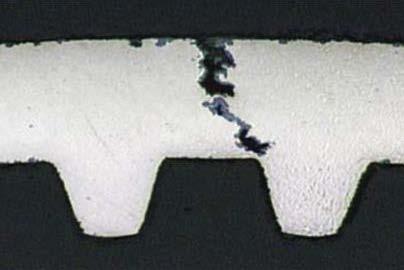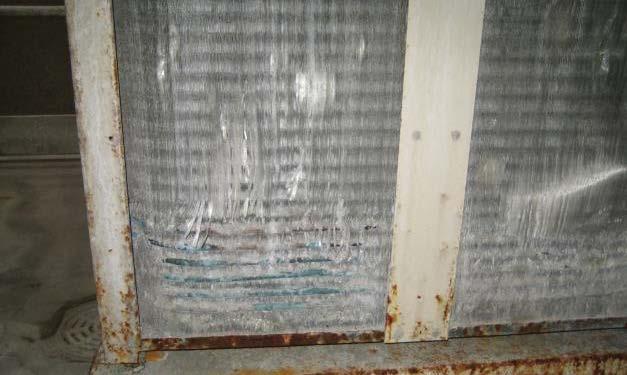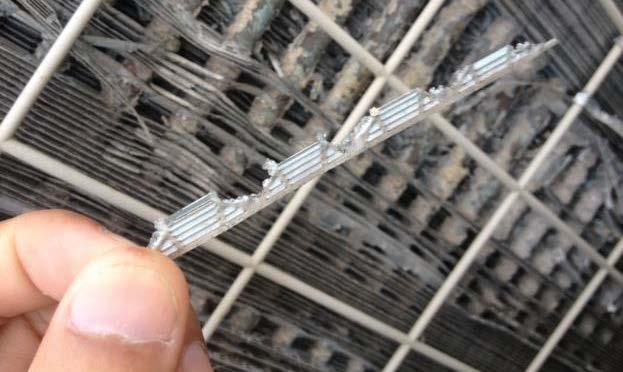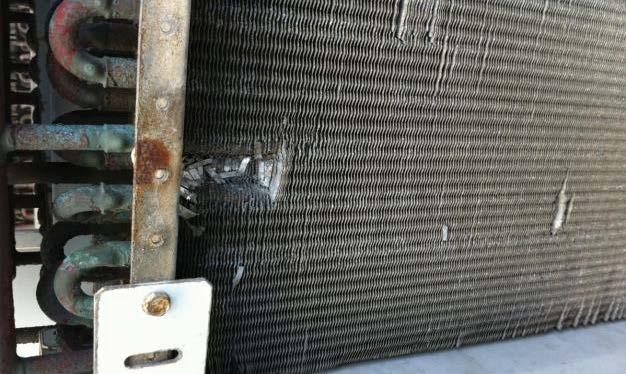
9 minute read
Skills Workshop
by AIRAH
PROUDLY SPONSORED BY
REFRIGERATION 2020
Advertisement
Skills summary
■ What? A guide to the impacts of corrosion on HVAC&R equipment and strategies to prevent it.
■ Who? Relevant for mechanical contractors, consultants, engineers, building designers, sustainability/energy efficiency advisers, facility managers and building owners.
CORROSION AND ASSET PROTECTION
Corrosion is a huge contributor to unnecessary energy and efficiency loss. It will cause a loss in cooling performance, reduced indoor air quality, reduced reliability, reduced energy efficiency and a reduction in service life. These issues will cause such things as discomfort and health risks to building occupiers, higher running costs, higher capital costs and more CO2. But there are ways to limit or prevent this corrosion from occurring.
This Skills Workshop provides a step-by-step explanation and analysis of how HVAC&R equipment is affected by corrosion in heat exchanger coils. It looks at how this impacts on efficiency and how it can be prevented in new units or stopped in existing units.
According to the CSIRO, HVAC systems in buildings account for approximately 40–50 per cent of building energy use and contribute to 34.7 megatonnes of carbon dioxide emissions every year.
With electricity prices continuing to rise per year and with building energy contributing to Australia’s greenhouse gas emissions, HVAC&R energy efficiency is a major economic and environmental issue, even when not considering the increase in building construction and the expansion of building footprints that we currently see in Australia.
Heat exchanger geometry Air-cooled heat exchangers consist of fins mounted on tubes to expand the heat-exchanging surface. Tubes and fins can be made of several metals like steel, copper, aluminium and stainless steel. The heat exchangers, also called coils, may have various dimensions depending on the application. Most heat exchangers are made of copper tubes and aluminium fins. This is because aluminium is easy to process, light and relatively corrosion resistant.
Coil manufacturers use different fin forms to adjust the coil to the demands. The simplest form is the straight fin, a flat fin with only minor waves. More complicated is the louvred fin. This fin is perforated to create turbulence of air in the coil. This will increase the capacity of the coil.
A coil with this fin type will be much more vulnerable because of the thin aluminium louvres. The louvred fins have an air filtering effect and will be exposed to more pollution. Another option for creating more heat exchange capacity is a wavy fin. The waves will force the air to bounce against the aluminium. See Figure 1.
Condenser condition
Condensing temperature
Condensing pressure
Cooling capacity
Power consumption
Annual energy saving Untreated Protected Difference
Fins brittle Uncorroded —
104°C 93°C 11%
2.240kPa 1,827kPa 18%
299kW 326kW 9%
119kW 113kW 5%
— 30,390kWh 13%
Table 1
Corrosion of HVAC equipment With air-cooled systems, oxidation of the heat exchangers is a major problem. Aluminium is proven to be one of the most suitable materials for this kind of equipment. The advantages of aluminium are:
• Lightweight metal • Easy to shape • Good heat transfer • Cheap. The corrosion resistance of aluminium should be an advantage as well; unfortunately, this is not the case. Aluminium forms an oxide film as soon as it is exposed to air.
This action is damaging in that it reflects the tendency of the metal to return to its natural oxidation state. If the oxidation layer were evenly spread, it would protect the metal from corrosion. However, the oxidation layer is patchy, and because of the humidity and atmospheric pollution the process of oxidation or corrosion may accelerate here.
Another problem concerning air-cooled systems is the construction of aluminium heat exchangers.
Most aluminium heat exchangers use copper pipes. When two different metals in a conducting liquid are in direct contact with each other, corrosion of the least noble metal may be the result. The parts closest to the noble metal will be particularly affected.
This corrosion depends on:
• The potential difference between the two metals • The relationship between the two metals; the larger the cathode surface (the noble metal) compared to the anode surface (the base metal), the more corroded the latter will be • The conductivity of the solvent • The presence of oxygen.

Copper tube section – formicary corrosion caused by acetic acid Outer surface
A good solution would be aluminium-aluminium. Although this type of coil is becoming more and more popular, some reasons why manufacturers are not using aluminium-aluminium in general yet are:
• Tubes made out of aluminium are difficult to weld • The tubes would be damaged more easily because aluminium is softer than copper • It is easier to repair copper than it is to repair aluminium.
Sources and effects of HVAC corrosion HVAC corrosion is a widespread problem. Australia’s population is concentrated in industrialised, urban, coastal strips and agricultural regions. All these areas contain sources of corrosion on HVAC equipment. Salt and humidity in coastal regions, sulphur oxides, nitrous oxides, hydrocarbons, chlorides, ammonia, electrolytes and contaminated dust all contribute to corrosion.
Examples of sources are aluminium production plants, fertiliser production, petroleum and chemical production, mining and metallurgy, power generation, paper and pulp mills, sewage treatment plants, steel production, swimming pools and farms.
Environmental corrosion of the fin surfaces and galvanic corrosion at the tube‑fin breaks down this mechanism, which reduces maximum cooling capacity and energy efficiency as the refrigerant condensing temperature is raised to recover cooling performance.
Table 1 shows a case study of two identical chillers after four years of operation – one untreated, the other treated with a sprayed-on protective coating.
Corrosion of the copper pipes and headers (manifolds) can create pinhole leaks. Formicary corrosion caused by organic acids is a common cause of this type of failure. See Figure 2.
Soldered joints are particularly vulnerable to corrosion by sulphurous gases.
Preventing coil corrosion There are two ways to prevent HVAC corrosion. One is through materials selection to suit particular environments, the other is through protective coatings.
Mono-metal coils such as copper tube and fin or aluminium tube and fin will avoid galvanic corrosion but do not provide complete protection. For this method to be effective, expensive air testing and environmental assessments would be required to provide the best advice on what construction would be best suited for a particular environment.
A protective coating is the most readily available and most frequently applied protection measure. Protective coatings for HVAC can be classified in two separate areas: pre-coat (applied prior to coil assembly) and post-coat (applied after coil assembly).
Figure 2 Most manufacturers offer an epoxy pre-coat applied to the aluminium fin as the lowest cost option for improving the corrosion resistance of bare metal.
Post-coatings are the alternative to pre-coats. So, what do we need to consider when looking for corrosion prevention options for HVAC equipment?

6 years – city centre

<7 years – coastal

7 years – suburban

10+ years – rural township
Pre-coats only protect the aluminium fin, not the tubes or headers. After the fin is pre-coated, it is cut to size and holes punched in them for fitment to the copper tubes. This cutting exposes the aluminium which then comes into contact with the copper tubes; the beginning of the galvanic corrosion process. Polyurethane post-coat will cover all surfaces and joints of the fins and tubes.
Due to epoxy pre-coat’s low thermal conductivity, it creates an insulation layer at the critical fin-tube junction when fins are formed, and coil is assembled. This can create a capacity loss of up to 15 per cent. Some post-coats contain an aluminium pigment that boosts thermal conductivity. When combined with a low 25-micron dry film thickness (DFT), this can minimise thermal and pressure losses. Capacity losses with this type of coating are 0–3 per cent.
With age and exposure to the elements, epoxy pre-coats lose adhesion and have a lower mechanical resistance. The polyurethane post-coat has excellent adhesion to most metals, in particular aluminium and copper, plus have the added benefit of excellent UV and chemical resistance.
The post-coat treatment can be applied in the workshop or onsite and is maintainable, repairable and cleanable. Pre-coats are generally applied with no further ability to maintain or service onsite.
Conclusion HVAC&R efficiency loss accounts for a significant proportion of Australia’s energy consumption, business costs and CO2 emissions. Asset owners and managers are now even more aware of this, plus the high maintenance and replacement costs, and are looking for alternatives to prolong the life of their equipment.
Corrosion of heat exchanger coils is a widespread problem and one that adversely impacts the performance and energy efficiency of HVAC&R systems.
Applying the most effective treatment to these units will limit or prevent HVAC&R coil corrosion and its adverse impact, thus saving energy and money and making our environment more sustainable to live in.
References CSIRO, Reducing Energy Consumption in Commercial Buildings, March 2015 Jeroen de Wit, Blygold International, Blygold Operations Manual, Chapter 1, Coil Geometry, 2011 Jeroen de Wit, Blygold International, Blygold Operations Manual, Chapter 2, Corrosion, 2011 A. Bhatia, CED Engineering, New York, HVAC Design Considerations for Corrosive Environments , Page 7, 2012 Jeroen de Wit, Blygold International, Cost saving Analysis of Chiller Treated with Blygold and Chiller without Treatment , 1999 J.P.M. Rademaker MSc, Element Materials Technology, Amsterdam, The Netherlands, Salt Spray Testing Acc. To ASTM
Requirement Specification
1. High corrosion resistance
2. Effective cover
3. High thermal performance
4. Durability
5. On-site application and maintenance
6. Cost-effective Broad spectrum – urban; coastal; industrial; rural/agriculture
All vulnerable surfaces protected
Minimise reduction in thermal performance
Broad environmental resistance; long-lasting
• Can protect new and in‑service systems • Maintainable, repairable, cleanable
Acceptable return on investment
Table 2
This month’s Skills Workshop was provided by Blygold Oceania. It was written by Mark Weir (Blygold Oceania), David Fry (Blygold Victoria) and Darryl Rundle (Blygold SA-NT).


























